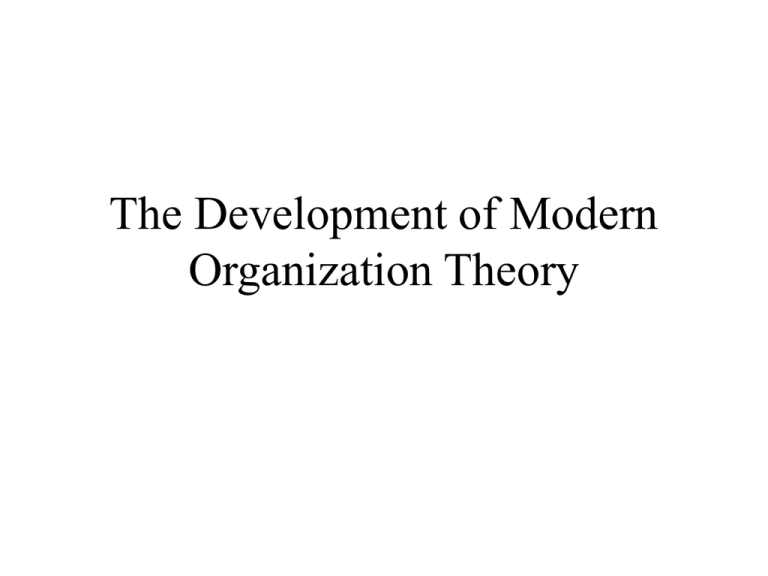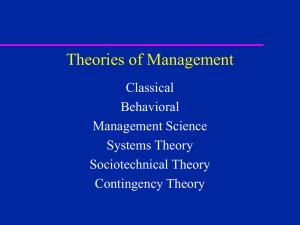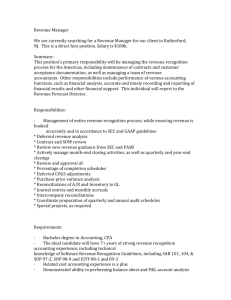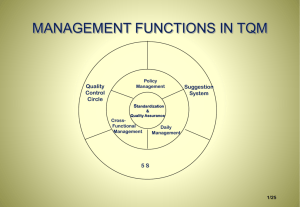The Development of Modern Organization Theory
advertisement

The Development of Modern Organization Theory Lecture Outline • Bureaucracy and administrative theory – concepts and limitations • Decision making theories of organization – concepts and interpretation • Open-systems theory – concepts and implications • Sociotechnical systems – the story, and what we learned Bureaucratic Models of Organization • Goal: describe the rational, efficient organization of tasks in society • Key players: K. Marx, M. Weber • Key concepts: – – – – hierarchical organization of authority division of labor chain of command unity of command Administrative Man • Describes the model of man that is assumed in the bureaucratic model of organization • Key players: H. Fayol and F. Taylor • man is a passive instrument • one best way to organize • ignored social aspect of organizational life • These assumptions led to significant limitations of bureaucratic models Limitations: the ‘unanticipated consequences of bureaucracy’ • Reductions in personalized relationships (results in anomie) • internalization of organizational rules results in inflexibility • increased use of categorization for decision making - reduces search for alternatives • departmentalization leads to bifurcation of interests among subunits • subunit goals become internalized Behavioral View of Organizations • Views individuals as decision making beings • individual characteristics and situations influence decision making • bounded rationality – we use simplifying models of reality • satisficing – decisions are made with limited information – we are rational only with respect to our frame of reference Behavioral View of Organizations • standard operating procedures (SOP’s) necessarily result: – problems are either novel or routine – routine problems are responded to by simple stimulusorganism-response pattern (based upon SOP) – novel problems are responded to by complex problem solving behavior: simulus-organism-search-standard setting-choice • Thus the eventual result is to distill all complex situations down to SOP’s - routinization Limitations of SOP’s • • • • • SOP’s determine problem definition SOP’s determine alternative solutions SOP’s constrain search activity SOP’s determine consequences SOP’s rules for ordering consequences Behavioral View of Organizational Structure • Basic features: – SOP’s; division of labor; communications patterns (e.g. hierarchy) • These result directly from the characteristics of human decision makers – bounded rationality – satisficing behavior Organizations as ‘Open Systems’ • Emphasis upon intimate relationship between system and environment • open systems can be characterized in terms of: – – – – – – input - energy, information throughput - processing of energy and information output - product, information feedback homeostasis - steady state (balance inputs and outputs) differentiation - specialized functions Implications of OST 1) Organizations are continually dependent upon the environment for inputs 2) We cannot assume factor inflows as given 3) There will be 5 major functional subsystems: – – – – production support - procurement, disposal, institutional relations maintenance adaptive - planning, R&D, intelligence or feedback function – managerial - control Sociotechnical Systems View • Result of a study of the mechanization of British coal faces by - Trist & Bamforth (1951) • The 'hand-got' system – interdependent work pairs – each with responsibility for the 'whole job' – Leadership and supervision were internal to the group – Choice of workmates was made by the men themselves Sociotechnical Systems View • Mechanization in the form of the 'longwall method' developed in response to the characteristics of British coal seams, being economically more efficient. • primary work unit grew to a group of 40-50 men, a shot firer and shift deputies (suprvisors). • 3 shifts: cutting, ripping, and filling • barriers to effective intergroup communication • close task interdependence between shifts • role segregation intensified by payment methods Sociotechnical Systems View The results of reorganization: functional interdependence is magnified uneven levels of functional efficiency uncertainty of conditions bad conditions resulting in overtime too many hours resulting in bad work a vicious cycle resulting from the above - even to the point of complete stoppage Sociotechnical Systems View defense mechanisms used to counteract the effects of mechanization: Informal organization Mutual scapegoating Self-compensatory absenteeism How did they fix it? reducing group size increasing integration within groups multiskilling increasing autonomy Story so far... • Bureaucracy and administrative views are rational models – they explain conditions for efficiency • Behavioral view is of bounded rationality – internal structure of organizations reflects this • OST describes organizations subject to environments – organizations must compete for and acquire resources • Sociotechnical systems suggests that efficiency needs may not override social system needs To be continued……….


